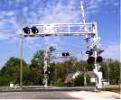
NPRM Spells Out Railroads' Risk Reduction Plans
Each Class I railroad, each railroad with an inadequate safety record, and each passenger railroad would have to submit a plan to the Federal Railroad Administration for its approval and then implement it.
A proposed rule from the Federal Railroad Administration to require risk reduction plans contains an interesting question: How should the agency determine which railroads have "inadequate safety records" and thus must submit a plan for FRA's approval? The Rail Safety Improvement Act of 2008 required this but does not say how it should be determined. (The plans also will be required of all Class I and passenger railroads.)
In its Dec. 8 proposal, FRA said it may weigh several safety factors, such as the railroad's safety performance within the last five years, as measured by the number of occurrences per million train-miles of:
- Fatal accidents/incidents reportable under 49 CFR part 225 (not including accidents/incidents occurring at highway-rail grade crossings unless they were caused by a railroad's failure to comply with a railroad operating rule or a federal law or regulation)
- The number, severity, and types (e.g., head-on collisions between pieces of on-track equipment) of accidents/incidents reportable under 49 CFR part 225
- Non-accident hazardous materials releases
- FRA safety violations/deficiencies
Other factors that may be considered are how the railroad's measured safety performance compares with other railroads of similar size and operations; any serious accident/incident involving hazardous materials and whether it caused an evacuation, environmental damage, or a personal injury/fatality; any recommendation made by an FRA regional administrator identifying a railroad with an inadequate safety record; and how much of the railroad's territory is excepted track under 49 CFR 213.4. (Railroads may designate a segment of track as excepted track subject to certain conditions, on such track a railroad may not operate trains in excess of 10 mph, operate occupied passenger trains, or operate freight trains containing more than five cars containing hazmats. Excepted track is subject to less stringent track safety standards, according to the rule.)
FRA asked for written comments by Feb. 7 on the rule, which says each risk reduction program would have to include a fatigue management plan, as well as risk-based hazard analysis of operating rules and practices; infrastructure; equipment; employee staffing levels and schedules; management structure; and employee training. An RRP also would have to include a Technology Implementation Plan describing how that railroad will develop, implement, and maintain "current, new, or novel technologies" on its system for a 10-year period to reduce the identified safety risks -- including positive train control systems, if the railroad is not already required to use them.